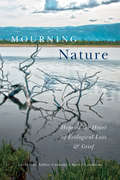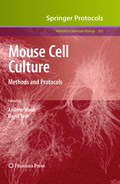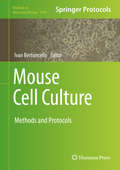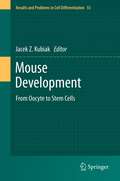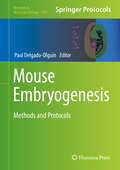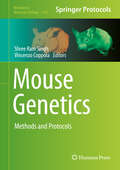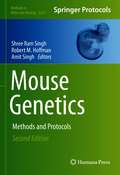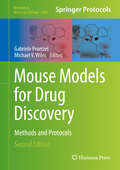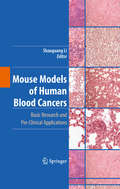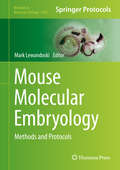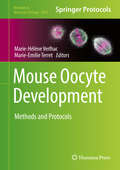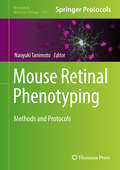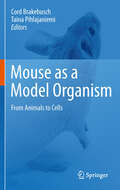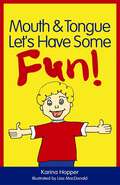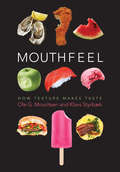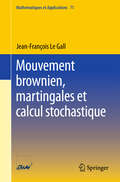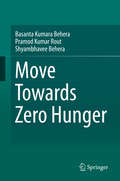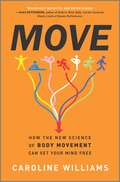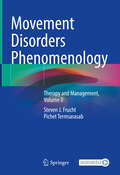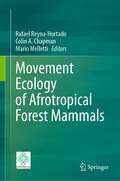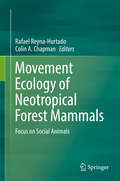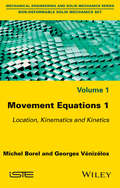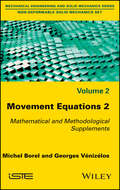- Table View
- List View
Mountains of Madness
by John Long Tim BowdenThis extraordinary book is the first-person account of John Long's two unforgettable "summers" on the southern continent. Told in a highly accessible and entertaining style, Mountains of Madness is the account of his three-month long fossil hunt. As the story unfolds, we learn of both the highs of scientific discovery as well as the grueling yet essential routines that must be practiced every day just to stay alive in one of the harshest environments on our planet. Alternating with the author's wonder at the intense beauty of his surroundings are his immense frustration and boredom that stem from being completely at the mercy of the elements.Throughout the course of the expedition, danger is never far off in this inhospitable land. Despite having been trained in the art of building snow caves and practiced in the skill of traversing glaciers, Long tells of two brushes with death in just one afternoon. The hair-raising escape from a deep crevasse is fraught with tension-only to be followed by yet another encounter with sudden disaster when the crash of an avalanche buries Long deep in the snow.
Mountains, Earthquakes, and Volcanoes (Science Support Readers)
by Houghton MifflinScience support reader covering: How mountains form, what happens during an earthquake, how earthquakes are located and measured, and how volcanoes form.
Mourning Nature: Hope at the Heart of Ecological Loss and Grief
by Ashlee Cunsolo Karen LandmanWe are facing unprecedented environmental challenges, including global climate change, large-scale industrial development, rapidly increasing species extinction, ocean acidification, and deforestation – challenges that require new vocabularies and new ways to express grief and sorrow over the disappearance, degradation, and loss of nature. Seeking to redress the silence around ecologically based anxiety in academic and public domains, and to extend the concepts of sadness, anger, and loss, Mourning Nature creates a lexicon for the recognition and expression of emotions related to environmental degradation. Exploring the ways in which grief is experienced in numerous contexts, this groundbreaking collection draws on classical, philosophical, artistic, and poetic elements to explain environmental melancholia. Understanding that it is not just how we mourn but what we mourn that defines us, the authors introduce new perspectives on conservation, sustainability, and our relationships with nature. An ecological elegy for a time of climatic and environmental upheaval, Mourning Nature challenges readers to turn devastating events into an opportunity for positive change. Contributors include Glenn Albrecht (Murdoch University, retired); Jessica Marion Barr (Trent University); Sebastian Braun (University of North Dakota); Ashlee Cunsolo (Labrador Institute of Memorial University); Amanda Di Battista (York University); Franklin Ginn (University of Edinburgh); Bernie Krause (soundscape ecologist, author, and independent scholar); Lisa Kretz (University of Evansville); Karen Landman (University of Guelph); Patrick Lane (Poet); Andrew Mark (independent scholar); Nancy Menning (Ithaca College); John Charles Ryan (University of New England); Catriona Sandilands (York University); and Helen Whale (independent scholar).
Mouse Cell Culture
by Andrew Ward David ToshCultured cells have combined accessibility and the ability to expand a homogeneous cell population from a relatively limited source, thus opening up a wealth of possibilities for researchers. In Mouse Cell Culture: Methods and Protocols, expert researchers provide a number of methods for the culture of a wide range of specific cells and tissues isolated from the key genetic model of the fetal or adult mouse. Including protocols for the explant of fetal tissues and stem cells that allow developmental processes to be followed ex vivo as well as protocols for the culture of isolated cell types that allow for the study of relatively homogeneous cell populations, this volume brings together a selection of the most current methods in order to make them available in one convenient source. Written in the highly successful Methods in Molecular BiologyTM series format, chapters include introductions to their respective topics, lists of the necessary materials and reagents, step-by-step, readily reproducible laboratory protocols, and notes on troubleshooting and avoiding known pitfalls. Practical and authoritative, Mouse Cell Culture: Methods and Protocols serves as an immediately applicable springboard for the development of new tissue culture methods in order to advance the study and treatment of human disorders.
Mouse Cell Culture: Methods and Protocols (Methods in Molecular Biology #1940)
by Ivan BertoncelloThis volume describes cell culture protocols for the maintenance, propagation, manipulation, and analysis of primary explanted cells from various mouse organ systems. After introductory chapters that examine the applicability of mouse models as a discovery tool and describe critical factors and variables that influence cell culture endpoints, protocol chapters explore cell culture methodologies for specific mouse cell types and lineages. Written in the highly successful Methods in Molecular Biology series format, these chapters include introductions to their respective topics, comprehensive lists of the essential materials and reagents, step-by-step, readily reproducible laboratory protocols, and tips on troubleshooting and avoiding known pitfalls. Authoritative and cutting-edge, Mouse Cell Culture: Methods and Protocols aims to ensure successful results utilizing these protocols in further studies, leading to the identification of key factors, genes, and cellular pathways regulating cell lineage commitment and differentiation, modeling disease, and identifying novel therapeutic targets.
Mouse Development
by Jacek Z. KubiakThe mouse is a perfect model organism to study mammalian, and thus indirectly also human, embryology. Most scientific achievements that have had an important impact on the understanding of basic mechanisms governing embryo development in humans, originated from mouse embryology. Stem cell research, which now offers the promise of regenerative medicine, began with the isolation and culture of mouse embryonic stem cells by Martin Evans (who received the Nobel Prize in medicine in 2007 for this achievement) and Matthew Kaufman. This book provides an overview of mouse development, spanning from oocytes before fertilization to the state-of-the-art description of embryonic and adult stem cells. The chapters, written by the leading specialists in the field, deal with the most recent discoveries in this extremely fast-developing area of research.
Mouse Embryogenesis: Methods And Protocols (Methods In Molecular Biology #1752)
by Paul Delgado-OlguinThis volume explores protocols for identifying mutant mice and characterizing parts of their anatomical, functional, cellular, and molecular phenotypes. The chapters in this book look at anatomical and functional phenotyping using quantitative imaging, isolation of specific embryonic cell types for cell culture, analysis of gene expression, and how to define chromatin structure. Written in the highly successful Methods in Molecular Biology series format, chapters include introductions to their respective topics, lists of the necessary materials and reagents, step-by-step, readily reproducible laboratory protocols, and tips on troubleshooting and avoiding known pitfalls.Cutting-edge and authoritative, Mouse Embryogenesis: Methods and Protocols is a valuable resource for experimentalists interested in discovering new aspects of embryogenesis control, organ function, and the origin of disease.
Mouse Genetics
by Shree Ram Singh Vincenzo CoppolaMouse Genetics: Methods and Protocols provide selected mouse genetic techniques and their application in modeling varieties of human diseases. The chapters are mainly focused on the generation of different transgenic mice to accomplish the manipulation of genes of interest, tracing cell lineages and modeling human diseases. Composed in the highly successful Methods in Molecular Biology series format, each chapter contains a brief introduction, a list of necessary materials, systematic, readily reproducible methods and a notes section, which shares tips on troubleshooting in order to avoid known pitfalls. Comprehensive and authoritative, Mouse Genetics: Methods and Protocols promises to deliver fundamental techniques and protocols to geneticists, molecular biologists, cell and developmental biologists, students and postdoctoral fellows working in the various disciplines of mouse biology and modeling human disease.
Mouse Genetics: Methods and Protocols (Methods in Molecular Biology #2224)
by Shree Ram Singh Robert M. Hoffman Amit SinghThis fully updated edition provides selected mouse genetic techniques and their application in modeling varieties of human diseases. The chapters are mainly focused on the generation of different transgenic mice to accomplish the manipulation of genes of interest, tracing cell lineages, and modeling human diseases. Written for the highly successful Methods in Molecular Biology series, chapters include introductions to their respective topics, lists of the necessary materials and reagents, step-by-step, readily reproducible laboratory protocols, and tips on troubleshooting and avoiding known pitfalls. Authoritative and up-to-date, Mouse Genetics: Methods and Protocols, Second Edition delivers fundamental techniques and protocols to geneticists, molecular biologists, cell and developmental biologists, students, and postdoctoral fellows working in the various disciplines of genetics, developmental biology, mouse genetics, and modeling human diseases.
Mouse Models for Drug Discovery
by Gabriele Proetzel Michael V. WilesAs the drug discovery process shifts more and more toward specifically targeting pathways and molecules, model systems continue to increase in importance, and the mouse, with its versatility, ease of use, and remarkable similarity to the human genome, has clearly risen to the forefront of animal model studies. In Mouse Models for Drug Discovery: Methods and Protocols, experts in the field present some background for those less familiar with mice as experimental model platforms as well as a collection of techniques involving general methods as well as specific disease topics such as type 1 and 2 diabetes, cardiovascular disease, arthritis, skin disorders, cancer, the use of behavioral models for depression and anxiety, neurodegenerative diseases, neuromuscular diseases, and infectious diseases. Written in the highly successful Methods in Molecular BiologyTM series format, chapters include introductions to their respective topics, lists of the necessary materials and reagents, step-by-step, readily reproducible laboratory protocols, and notes on troubleshooting and avoiding known pitfalls. Authoritative and easy-to-use, Mouse Models for Drug Discovery: Methods and Protocols will stimulate those not familiar with the power of the mouse and its potential for the drug discovery process, and it will encourage the development of new models and new ways to utilize existing models in order to further the use of this dynamic animal in this vital field.
Mouse Models of Human Blood Cancers
by Shaoguang LiIn this book, Dr. Li and his author team plan to emphasize why mouse models are useful in vivo systems for understanding disease mechanisms and developing therapeutic strategies in blood cancers. The authors do not intend to cover all types of blood cancers; instead, they will focus on some major ones such as leukemias and lymphomas. However, the authors will try to cover as much as they can the cancer types and point out that many blood cancers need to be studied in mouse disease models although they are still not available at present. A major focus in the book will be to show what we can or cannot learn from mouse disease models and to also show the critical contributions of mouse models in therapeutic drug development.
Mouse Molecular Embryology
by Mark LewandoskiIn Mouse Molecular Embryology: Methods and Protocols, expert researchers in the field detail many of the protocols used to study mouse embryology. These include protocols and techniques that are "close to the embryo" such as, manipulating embryonic gene expression, culturing explanted embryonic tissue and harvesting embryonic RNA. With additional chapterson fluorescence imaging, lineage tracing, and genetic ablation. Written in the highly successful Methods in Molecular Biology series format, chapters include introductions to their respective topics, lists of the necessary materials and reagents, step-by-step, readily reproducible laboratory protocols, and key tips on troubleshooting and avoiding known pitfalls. Authoritative and practical, Mouse Molecular Embryology: Methods and Protocols seeks to aid scientist in the further study of mouse embryo and its relation to other aspects of biological research.
Mouse Oocyte Development: Methods and Protocols (Methods in Molecular Biology #1818)
by Marie-Hélène Verlhac Marie-Emilie TerretThis book details methods on various aspects of the very final stages of mouse oocyte development. Chapters guide the reader through in vitro growth of follicles, production of a fully-grown competent mouse oocyte, meiosis resumption, analysis of spindle assembly and chromosome segregation, analysis of the oocyte and early embryo transcriptome. Written in the highly successful Methods in Molecular Biology series format, chapters include introductions to their respective topics, lists of the necessary materials and reagents, step-by-step, readily reproducible laboratory protocols, and tips on troubleshooting and avoiding known pitfalls. Authoritative and cutting-edge, Mouse Oocyte Development: Methods and Protocols aims to help scientists with the set up both live and fix experiments required to study the process of oocyte meiotic maturation.
Mouse Retinal Phenotyping: Methods And Protocols (Methods In Molecular Biology #1753)
by Naoyuki TanimotoThe aim of this volume is to provide a wide range of techniques and aspects of mouse retinal phenotyping and characterization. Chapters guide readers through morphological and functional properties of the mouse retina and techniques for the analysis of outer to mid-retina and mid- to inner retina. Written in the highly successful Methods in Molecular Biology series format, chapters include introductions to their respective topics, lists of the necessary materials and reagents, step-by-step, readily reproducible laboratory protocols, and tips on troubleshooting and avoiding known pitfalls. Authoritative and cutting-edge, Mouse Retinal Phenotyping: Methods and Protocols aims to ensure successful results in the further study of this vital field.
Mouse as a Model Organism
by Cord Brakebusch Taina PihlajaniemiCell culture based research is important for our understanding of biological processes at the cellular and molecular level. Using this approach, the previous decades have produced a wealth of mechanistic information in all areas of biomedical research. Such in vitro research, however, lacks the complexity of in vivo investigations, where many different cell types interact with each other in a normal, three-dimensional environment, with normal levels of cytokines and growth factors. Furthermore, complex human diseases, such as cancer, diabetes or chronic inflammation, can only be modeled in vivo. Due to its small size, its short reproduction time, and the possibility to introduce specific gene mutations, the mouse has become the favourite mammalian model organism to study in vivo function of genes during development and in disease. This book combines review articles on selected subjects presented at the symposium "Mouse as a Model Organism - From Animals to Cells", held in Rovaniemi, Finland, 2009. Among other topics, high-throughput phenotyping of mouse mutants, mouse phenotypes dependent on nature and nuture, and a spectrum of in vivo, ex vivo and in vitro methods to study cancer in mice are described. This book will give an excellent introduction to scientists interested in the use of mice as a model to understand complex biological questions in the post-genomic era. It will highlight the possibilities, but also discuss the current problems and shortcomings, to give a realistic view of the current state-of-art in this fascinating field of biomedical research.
Mouth and Tongue Let's Have Some Fun!
by Karina HopperLearning new facial expressions and mouth movements can be great fun, just ask Sam!Moving the tongue and mouth in different ways is very effective for strengthening facial muscles and aiding speech development, so this simple picture book is a must for anyone worried that a child's speech is showing signs of delay. Children will love copying Sam and Timmy Tongue's funny faces and improve their facial strength and dexterity in the process. This book will be an invaluable resource for any parent, teacher or professional looking to help a child with delayed speech.
Mouthfeel: How Texture Makes Taste (Arts and Traditions of the Table: Perspectives on Culinary History)
by Klavs Styrbæk Ole MouritsenWhy is chocolate melting on the tongue such a decadent sensation? Why do we love crunching on bacon? Why is fizz-less soda such a disappointment to drink, and why is flat beer so unappealing to the palate? Our sense of taste produces physical and emotional reactions that cannot be explained by chemical components alone. Eating triggers our imagination, draws on our powers of recall, and activates our critical judgment, creating a unique impression in our mouths and our minds. How exactly does this alchemy work, and what are the larger cultural and environmental implications?Collaborating in the laboratory and the kitchen, Ole G. Mouritsen and Klavs Styrbæk investigate the multiple ways in which food texture influences taste. Combining scientific analysis with creative intuition and a sophisticated knowledge of food preparation, they write a one-of-a-kind book for food lovers and food science scholars. By mapping the mechanics of mouthfeel, Mouritsen and Styrbæk advance a greater awareness of its link to our culinary preferences. Gaining insight into the textural properties of raw vegetables, puffed rice, bouillon, or ice cream can help us make healthier and more sustainable food choices. Through mouthfeel, we can recreate the physical feelings of foods we love with other ingredients or learn to latch onto smarter food options. Mastering texture also leads to more adventurous gastronomic experiments in the kitchen, allowing us to reach even greater heights of taste sensation.
Mouvement brownien, martingales et calcul stochastique
by Jean-Francois Le GallCet ouvrage propose une approche concise mais complète de la théorie de l'intégrale stochastique dans le cadre général des semimartingales continues. Après une introduction au mouvement brownien et à ses principales propriétés, les martingales et les semimartingales continues sont présentées en détail avant la construction de l'intégrale stochastique. Les outils du calcul stochastique, incluant la formule d'Itô, le théorème d'arrêt et de nombreuses applications, sont traités de manière rigoureuse. Le livre contient aussi un chapitre sur les processus de Markov et un autre sur les équations différentielles stochastiques, avec une preuve détaillée des propriétés markoviennes des solutions. De nombreux exercices permettent au lecteur de se familiariser avec les techniques du calcul stochastique. This book offers a rigorous and self-contained approach to the theory of stochastic integration and stochastic calculus within the general framework of continuous semimartingales. The main tools of stochastic calculus, including Itô's formula, the optional stopping theorem and the Girsanov theorem are treated in detail including many important applications. Two chapters are devoted to general Markov processes and to stochastic differential equations, with a complete derivation of Markovian properties of solutions in the Lipschitz case. Numerous exercises help the reader to get acquainted with the techniques of stochastic calculus.
Move Towards Zero Hunger
by Basanta Kumara Behera Pramod Kumar Rout Shyambhavee BeheraSome geographic regions around the globe that are rich in terms of modern agriculture technologies, face a dilemma when it comes to storing excess produce, such as grains and even seasonal fruits and vegetable. They are often forced to destroy the surplus agricultural products due to the constraints of poor logistic systems, food warehouses and micro-economy system management.In contrast, millions of people in extreme rural areas are suffering from hunger and poverty. This book offers suggestions to resolve the problems of food security and poverty in rural areas and ensure minimum social justice so that those in rural areas have regular access to food and shelter. It also discusses how to develop sustainable foundations in extreme rural locations using indigenous resources to tackle issues like hunger, malnutrition, and chronic health problems.
Move: How the New Science of Body Movement Can Set Your Mind Free
by Caroline WilliamsAn eye-opening journey into the power of human movement and how we can harness it to optimize our brain health, boost our mood and improve every aspect our livesFor our earliest ancestors who hunted and gathered, movement meant survival. Our brains evolved to reward physical activity. Moving, thinking and feeling have always been inextricably linked.Yet what happens when we stop moving? Today, on average, we spend around 70% of our lives sitting or lying completely still. Our sedentary lifestyle—desk jobs, long commutes and lots of screen time—is not only bad for our bodies. It can also result in anxiety, depression and a lower overall IQ.But there’s good news. Even the simplest movements can reactivate our bodies and open up a hotline to our minds, improving our overall well-being and longevity. And we don’t have to spend countless hours in the gym. In fact, exercise as we understand it misses the point.Veteran science journalist Caroline Williams explores the cutting-edge research behind brain health and physical activity, interviewing scientists from around the world to completely reframe our relationship to movement. Along the way she reveals easy tricks that we could all use to improve our memory, maximize our creativity, strengthen our emotional literacy and more. A welcome counterpoint to the current mindfulness craze, Move offers a more stimulating and productive way of freeing our caged minds to live our best life.
Movement Disorders Phenomenology: Therapy and Management, Volume II
by Steven J. Frucht Pichet TermsarasabThis practical, case-based book offers an approach to diagnosis and treatment of movement disorders in the outpatient setting. The major hypokinetic and hyperkinetic disorders are considered in turn, with more than 1,000 videos illustrating the role of phenomenology in the diagnosis and treatment of these conditions. Discussion of the role of ancillary testing (imaging, genetic testing) and treatment options with medications, botulinum toxin injections, and surgical intervention are woven in to the discussion of cases throughout the book. Special attention is directed to pitfalls and perils of office-based practice. This volume will be of interest to movement disorders neurologists and trainees, general neurologists, neurology residents, and any healthcare professional with an interest in exploring the application of the many treatments that have transformed movement disorders into a therapeutic field. Rather than a textbook of movement disorders, thisvolume will help the practicing clinician in guiding the thought process for evaluation and management of patients in the clinic.
Movement Ecology of Afrotropical Forest Mammals
by Mario Melletti Colin A. Chapman Rafael Reyna-HurtadoThis book brings a unique perspective to animal movement studies because all studies come from African tropical environments where the great diversity, either biological and structurally (trees, shrubs, vines, epiphytes), present the animals with several options to fulfil their basic needs. These conditions have forced the evolution of unique movement patterns and ecological strategies. The book follows on our previous book “Movement Ecology of Neotropical Forest Mammals” but focuses on tropical African forests. Movement is an essential process in the life of all organisms. Animals move because they are looking for primary needs such as food, water, cover, mating and to avoid predators. Understanding the causes and consequences of animal movement is not an easy task for behavioural ecologists. Many animals are shy, move in secretive ways and are very sensible to human presence, therefore, studying the movements of mammals in tropical environments presents logistical and methodological challenges. However, researchers have recently started to be solved these challenges and exciting new information is emerging. In this book we are compiling a set of extraordinary studies where researchers have used new technology and the strongest methodological approaches to understand movement patterns in wild African forest mammals. This second book should inspire early career researchers to investigate wild mammal´s movements in some of the most amazing forest in the world: African tropical forests.
Movement Ecology of Neotropical Forest Mammals: Focus On Social Animals
by Colin A. Chapman Rafael Reyna-HurtadoThis book brings a unique perspective to animal movement studies because all cases came from tropical environments where the great diversity, either biological and structurally (trees, shrubs, vines, epiphytes), presents the animal with several options to fulfill its live requirements. These conditions have forced the evolution of unique movement patterns and ecological strategies. Movement is an essential process in the life of all organisms. Animals move because they are hungry, thirsty, to avoid being eaten, or because they want to find mates. Understanding the causes and consequences of animal movement is not an easy task for behavioural ecologists. Many animals are shy, move in secretive ways and are very sensible to human presence, therefore, studying the movements of mammals in tropical environments present logistical and methodological challenges that have recently started to be solved by ecologist around the world. In this book we are compiling a set of extraordinary cases where researchers have used some of the modern technology and the strongest methodological approaches to understand movement patterns in wild tropical mammals. We hope this book will inspire and encourage young researchers to investigate wild mammal´s movements in some of the amazing tropical environments of the world.
Movement Equations 1: Location, Kinematics and Kinetics
by Georges Vénizélos Michel BorelThe set of books on Mechanical Engineering and Solid Mechanics, of which this book is the first volume, is an essential tool for those looking to develop a rigorous knowledge of the discipline, whether students, professionals (in search of an approach to a problem they are dealing with), or anyone else interested. This volume deals with the elements required for establishing the equations of motion when dealing with solid bodies. Chapter 1 focuses on the systems of reference used to locate solid bodies relative to the observer, and demonstrates how to describe their position, orientation, and evolution during their motion. Chapter 2 introduces descriptors of motion such as velocity and acceleration, and develops the concept of torsor notation in relation to these descriptors. Finally, Chapter 3 concerns the notions of mass and inertia, as well as the kinetic torsor and dynamic torsor which consolidate the kinematic and kinetic aspects in a single concept. The set of books on Mechanical Engineering and Solid Mechanics, of which this book is the first volume, is an essential tool for those looking to develop a rigorous knowledge of the discipline, whether students, professionals (in search of an approach to a problem they are dealing with), or anyone else interested. This volume deals with the elements required for establishing the equations of motion when dealing with solid bodies. Chapter 1 focuses on the systems of reference used to locate solid bodies relative to the observer, and demonstrates how to describe their position, orientation, and evolution during their motion. Chapter 2 introduces descriptors of motion such as velocity and acceleration, and develops the concept of torsor notation in relation to these descriptors. Finally, Chapter 3 concerns the notions of mass and inertia, as well as the kinetic torsor and dynamic torsor which consolidate the kinematic and kinetic aspects in a single concept.
Movement Equations 2: Mathematical and Methodological Supplements
by Georges Vénizélos Michel BorelThe formalism processing of unbuckled solids mechanics involves several mathematical tools which are to be mastered at the same time. This volume collects the main points which take place in the course of the formalism, so that the user immediately finds what he needs without looking for it. Furthermore, the book contains a methodological formulary to guide the user in his approach.


